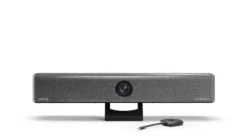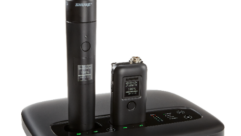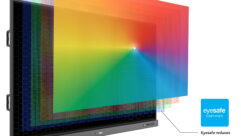
Wireless Microphones for Higher Education
May 11, 2012 2:42 PM,
By Bennett Liles
Solutions for today’s classroom environments.

RF receivers may be mounted in podiums without requiring external antennas. IR systems must have externally mounted coax-connected sensors.
The higher education environment is a hugely challenging place for AV people and gear. Trending toward more students, bigger classrooms, and tighter scheduling, colleges and universities are requiring more sound reinforcement for instructors. The equipment used for this must function in the same high up-time and mega-multi-user arena where the rest of the hardware must perform. High reliability and user friendliness are basic and essential requirements, especially where AV staffing is kept to a bare minimum.
In the multi-classroom campus, sound reinforcement for speech tends to be required by the same group of instructors in different classrooms on a varying schedule, while visiting lecturers are likely to require wireless microphones in the more spacious lecture halls. All of this introduces issues of microphone/transmitter mobility, permanent versus temporary installation, equipment security, and user friendliness. The typical solutions for wireless microphone use in the campus environment fall into three technical approaches. These are radio frequency systems, infrared equipment, and electronic field production (EFP) RF systems.

For long antenna cable runs with thick coax, special connectors are often needed.
RF, IR, or EFP
Each of the classroom microphone solutions has its own distinct set of advantages and challenges, so it is not unusual to see two or all three of them used in various places on the same campus. The traditional RF wireless mic systems are well-known to most AV techs, and they are simple to set up in temporary installations. As long as the classroom podium or instructor’s console is non-metallic, an RF receiver can rack or shelf-mount with other gear. It does work better if enough room is available inside the rack for the local UHF antennas on the unit to be extended up and out at 45-degree angles. If they are metallic whip types, direct contact with other metallic gear in the rack should be avoided. This will usually work for the minimal distances required by most instructors and visiting lecturers. Larger lecture halls with multiple receiver systems will normally require external antennas and coax connections to the receivers through antenna signal distributors, a type of which can be used in IR installs as well. The 50Ω coax normally used for RF antenna connections is RG-8/U, RG-58/U, or for long runs, the thicker RG-213/U.

The RF mic split for wireless camera sound feed.
The big downside to RF on campus is, of course, frequency coordination. Who is using which mic in what room and when? The microphones are not interchangeable between classrooms, so professors will have to switch mics between rooms because the prospect of users attempting to reset their own frequencies is too gruesome to contemplate. Does the mic stay in the classroom? Probably not for long unless it’s under lock and key. Who gets keys and does the microphone cabinet stay locked? With RF microphones issued to individual faculty members, they could quickly end up lecturing by radio to each other’s classrooms. The prospect of networked control over classroom RF mic receivers and setting their frequencies on a time schedule is an interesting scenario, but it gets less practical as the scale increases. With the development of drivers for networked receivers, their operation and frequency scheduling could be worked into the campus-wide AV network control application. For a small to medium-sized campus, this could enable each professor to be issued one microphone while the RF coordination is done on the receivers. For larger universities, RF microphone coordination can be a much more complex problem.
Enter infrared. Line of sight transmission beautifully solves the RF coordination problem and provides a low-cost signal security feature. This is the primary reason why IR wireless microphone systems have been strongly aimed at the academic market, but IR mic systems are not without their limitations. The signal might not only stop at the walls. It might stop at the presenter’s elbow when it’s in the wrong position or it could go silent when the lecturer turns to use the blackboard or to point at the projection screen. Whiteboards, however, can exhibit a limited amount of infrared reflectivity.
Infrared wireless mic transmitters use an LED to emit IR radiation to the sensors. The beam is modulated, in most cases switched on and off, to encode the voice data onto the IR carrier. The receivers use a photodiode to convert the photo beam to an electric current. From that point, the signal is carried over coax to the receiver in a method similar to that for RF.
IR systems typically require somewhat extensive sensor signal distribution systems on coax cable. In-line and rackmounted sensor distribution units can be used to allow more sensors to be either ceiling- or wall-mounted. IR sensor mounting locations must be more precise than those of RF antennas because reception can fall victim to a variety of interference sources including plasma displays, IR-assisted listening systems, infrared LAN links, incandescent lighting, and sunlight. For this reason, the light acceptance angle on many IR sensors can be adjusted to reduce interference from these infrared light sources. To save on coax, signal distributors can be mounted in the ceiling to run multiple IR sensors into a single coax to the receiver, but in addition to the loss in the cable, each distributor will also exhibit several decibals of loss. Seventy-five-ohm coax is normally used in IR installations, and the same signal loss characteristics apply here as with RF remote antenna installations. With RG-59/U the 100 meter loss is about 3.3dB. With RG6/U, the loss is 2.7dB and with RG11/U, it is 2.0dB. The thicker the cable, the lower the loss, the harder the runs are to make and, of course, the higher the price per foot.
1
Wireless Microphones for Higher Education
May 11, 2012 2:42 PM,
By Bennett Liles
Solutions for today’s classroom environments.

As long as the local RF antennas are not completely surrounded by metal, an internally mounted RF receiver can provide short distance pickup.
With IR systems particularly, it pays to mount the sensors, turn on all possible sources of interference, fire up the system and perform some experimentation before drilling holes and actually running the coax through the walls so that the location of the sensors can be changed easily during initial testing. Jumping through these installation hoops is the price paid for being able to completely shed any RF coordination problems later. IR channels are usually in the 2-3Mhz range and the wavelength of the IR signal from mic to sensor is around 850 nanometers.
The EFP-RF solution is based on the concept of having both transmitter and mobile battery-powered receiver issued to instructors so that as long as each classroom they use has a sound connection for the computer, it can be used for the wireless mic receiver instead. The hardware used is typical of that used in electronic field production where the small receiver is camera-mounted. The downside of this approach is that it requires a little more setup expertise on the part of the faculty member and there are two units running on batteries instead of only one. Such things tend to get left on until the batteries are dead. The EFP-RF method also requires faculty members to keep up with two pieces of hardware instead of just one, so as convenient as it is for RF coordination, this arrangement is normally offered only to the more tech-savvy professors. Some instructors have even provided their own such equipment, with little or no consideration as to what frequency it operates on and what interference it might cause.
There is another interesting wireless scenario on campus that comes into play on occasions when a video recording is needed for an event such as a conference or a visiting lecturer. A sound feed to the back of the room may not be available if the room sound system is using hardwired microphones. In such cases, there is usually a separate wireless lapel mic clipped to the presenter to provide a wireless feed to the receiver on the video camera at the back of the room. However, if there are multiple presenters to be recorded it gets cumbersome to swap lapel mics between them. One solution is to use a splitter transformer inside the podium and to lead the podium mic signal through the direct leg of the splitter to the PA input as usual. The isolated split output is connected to a short adapter cable and into a bodypack transmitter taped vertically inside the non-metallic podium or lectern. The hardwired podium mic works as before with separate level control while the arrangement provides a wireless video feed to the back of the room for the camera. The direct microphone line through the splitter to the mixer will also allow the room’s mixer to continue providing any phantom power needed for a condenser mic on the podium but will not be affected by any level changes on the mixer.

The splitter and adapter cable can be used to provide a wireless camera sound feed across a room using the existing podium microphone.
Sound Control
The other side of the classroom wireless mic equation is how the sound from the receiver is controlled in reference to other sound sources. Should the wireless microphone receiver gain be set and left at a constant level or should users have the ability to vary it, with possible consequences of audio feedback? In many classroom sound installations, it is left for users to vary the mouth-to-microphone proximity to control the volume, but when a battery-powered EFP receiver is connected to the computer sound cable on a podium, the computer sound level control obviously is applied to the wireless mic receiver output.
Many university lecture halls employ a dual and redundant sound system setup with all of the podium media sources such as mobile computing device, disc player, and other audio sources being on separate mixer or switcher inputs whose selection follows that of the video sources on the podium control panel. The user’s volume control is the switcher’s master gain sent to the amplifier and it applies these sound sources to a set of stereo or surround sound speakers. At the same time, the wireless mic receiver’s output is fed directly to a second amplifier whose gain is set and enclosed in the locked podium. The mic amplifier output is conveyed to ceiling speakers arranged all over the room so as to maximize gain before feedback. In this setup there are two separate amps feeding different sources to separate specialized sets of speakers. This is typically the most initially expensive but most user-friendly arrangement for integration of a wireless microphone with other sound sources.
When an EFP receiver output is connected to the sound cable for the mobile computing device on a podium, the podium AV controller’s programming must reflect the selection of that sound source for normally non-sound items such as document cameras. In this way, the professor can go back and forth between displaying computer and document camera with no interruption of the wireless mic sound. In planning such classroom AV control features, a central consideration is the choice between sound sources being exclusively switched or mixed. With only a few sources such as computer, media player, and visualizer, a switcher can easily handle the job, but if there are many sound sources and live narration over media playback, a mixing scenario is required. The real challenge in this one is in making it user friendly. One of the most profound challenges for AV on a university campus is the huge variety of daily users each system will have and their broad range of technical competency along with their willingness to use the technology.

The electronic field production (EFP) solution uses a mobile transmitter and receiver.
The mixing setup will normally require a combination mixer/amp with a DC remote-controlled master volume feature that uses an external converter to change RS-232 serial commands from the podium AV controller to a DC voltage applied to the remote volume terminals on the mixer/amp. All sound sources, including the microphone receiver, are fed to various inputs on the mixer/amp. The individual gains of the sound devices are initially set on the mixer’s inputs and the master volume is remotely user controlled on the podium AV panel. Any sound source can be narrated over, but the relative gains between microphone and other sources are typically not adjustable except by accessing the mixer—which should be safely locked inside the podium or AV cabinet. This is sometimes known as the “all-on” sound configuration. Any sound source is heard whenever it is played no matter which video source is selected.
For simple classroom AV setups with few sources, a switcher with a dedicated auxiliary input can be the answer. These switch sound from only the video source that is selected on the podium AV controller, but the aux input, used for the mic receiver, is manually set on the unit and applied to the switcher’s output along with any other sound source selected. Users have no control over mic volume, but their mic will be heard regardless of the other single sound source selected.
Higher education is the most challenging AV environment and the right choice for wireless microphone signal conveyance (RF, IR, or EFP) will depend on the uses for each classroom, the type of classes taught, and the number of present and future wireless microphone users. The sound control method employed should remain transparent to users while uniquely serving their needs.
2










